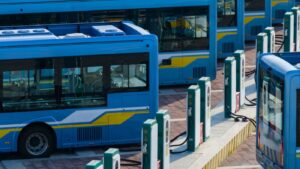Electrifying the Last Mile of Logistics
Medium and heavy-duty trucks account for 24% of transportation emissions in the U.S., representing the second largest segment after light-duty vehicles. Although some sectors, such as buses, have made progress in electrifying operations, the trucking sector has been slow to adopt low-emission technology. Long-range and high-payload capacity requirements have proven to be two major barriers for fully-electric technology for shipping. The path to electrifying heavy-duty shipping operations will require a piecemeal approach combined with the leveraging of different technologies, such as:
• Hydrogen
• Hybrid-electric
• Low-emission LNG
• Biodiesel.
However, another sector of the trucking industry, last-mile delivery, is well-suited for fully electric operations in the near term. Last mile delivery is defined as the final leg of a product’s journey to the customer’s doorstep. It is a significant logistics challenge for shipping companies and the trucks used for this bit of the journey are highly polluting. Last mile delivery represents 53% of the total cost of shipping an item and is, by far, the most inefficient piece of the journey. The short-haul nature of this segment and regular return-to-base operations reduce the range requirements and simplify deployment of charging infrastructure, making fully electric operations feasible.
Business Models
Newcomers to the industry have been able to develop innovative business and operating models in order to:
• Reduce the upfront cost of electric medium-duty vehicles
• Develop purpose-built vehicles designed for the specific requirements of the last-mile segment
• Provide energy services to help fleets make the transition to electric
Arrival, a UK-based startup, has developed short-haul electric trucks based on a flexible skateboard platform and customizable components, including materials and software designed to adapt their solutions to the needs of customers. The company operates micro-factories, which can be deployed near customers’ hubs, to manufacture the vehicles, adjust to varying demand and maximize profitability. This model has made the upfront cost of the vehicles the same as its diesel counterparts, but with a 50% reduction in total cost of ownership.
Chanje, a southern California-based startup developing purpose-built electric regional delivery vehicles, offers full stack solutions for electrifying fleets. The company’s energy solutions are specified to the needs of fleets and will involve an integration of fast-charging stations, renewable energy, storage and grid services deployed at fleet depots. This service model for charging and energy management gives fleets the lowest possible price for charging and allows them to focus on delivering packages, not managing energy use. Fleets can pay for Chanje’s charging-as-a-service (CaaS) by mile, kWh, time or another factor according to need.
Competition
Earlier this month, Ford announced a 2022 launch in the U.S. of an all-electric version of the company’s Transit cargo van, following a 2021 launch in Europe. The European launch is primarily to comply with emissions regulations, but the U.S. launch is an expansion of the company’s significant bet on electric vehicles, a bet that goes beyond just privately-owned automobiles. The transit cargo van, which will include ‘smart technology,’ will be able to provide fleet efficiency and compete with promising newcomers, such as Arrival and Chanje. Ford’s ability to scale the new product combined with its deep pockets and existing relationships with shipping companies could give the incumbent a competitive edge. Innovators, however, could win out with their business models, vehicle designs and by leveraging expertise in other areas of the value chain, such as charging and energy management.
Chanje has partnered with FedEx to electrify 42 stations in California and deliver 1,000 Chanje V8100 electric delivery vehicles to the fleet. The company developed the V8100 from the ground up as a purpose-built vehicle for the last-mile delivery segment, offering 6,000 lbs payload and 150 miles of range. Chanje has also previously entered a channel partnership with Ryder. Arrival raised $111 million from Hyundai and Kia in its January Series B round. Arrival, Hyundai and Kia will co-develop electric vans based on Arrival’s skateboard platform and other logistics, ride-hailing and shuttle products and services. Later that month, UPS announced plans to order 10,000 of Arrival’s delivery vans by 2024 and potentially 10,000 more after that.
Rivian is also pushing into this space with an order for 100,000 electric delivery vans from Amazon, as announced late last year. Although details of the van have not been released, it will likely be based on Rivian’s flexible skateboard platform. The contract, worth billions of dollars, is Rivian’s only order for delivery vans, and the company has no plans to build delivery vans for other companies at this time.
On the components side, incumbent heavy-duty vehicle suppliers are entering this market. Proterra and Freightliner Custom Chassis Corporation (FCCC) recently entered a partnership to develop the MT50e, a chassis for all-electric delivery trucks. The chassis will be built on FCCC’s MT platform and include Proterra’s battery system and support a Gross Vehicle Weight Rating (GVWR) of 16,000 to 23,000 lbs with a 125-mile range.
Keep an Eye Out For…
Booming e-commerce will only push demand for delivery vans higher. Plus, fuel economy regulations and emission reduction goals of cities and e-commerce companies will hopefully make a large portion of those new vans electric. More OEMs will likely enter this space, especially those with flexible platforms that can be adapted to the specifications of delivery trucks (looking at you, GM).
Check out my previous insight on Digitized Traffic Management to learn more about other emerging mobility trends.


